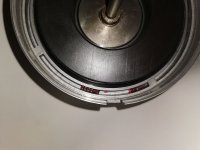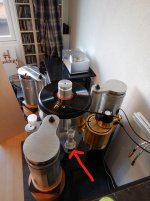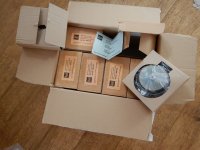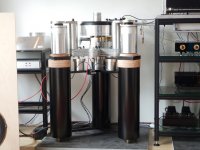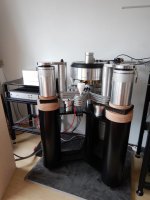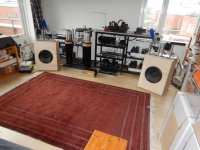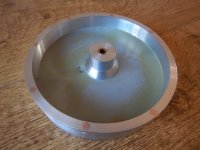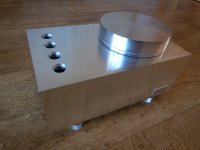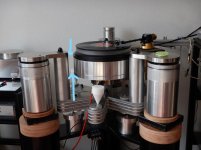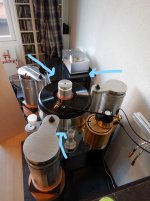Remember that the 701 is alike the 1229 in the DD world. Both saw the market's light in 1972, the 701 was the first European DD TT. Both the 1229 and 701 were built like tanks. Almost undestructible. Anyway, if the 701's motor electronics shows issues, fixing is hard, as the power transistors are germanium AC187/188K's.
Best regards!
Best regards!
Perhaps not surprisingly, AC187/8 are still available, if not from mainstream suppliers, then 'Thebay' has them for a couple of UK£ each.
The later 1000-2 uses silicon transistors, which can be substituted, along with a few other components which were also changed.
The cct diagrams for both are on the first page of this thread.
The later 1000-2 uses silicon transistors, which can be substituted, along with a few other components which were also changed.
The cct diagrams for both are on the first page of this thread.
Last edited:
I found my culprit. The magnet had slipped to the side. There is a small ridge on the rotor that locates the magnet. It had ridden up on that. That explains the rubbing and the out-of -balance. Slapping the rotor into my hand at the correct orientation and the magnet jumped straight back into place. I could have done this without dismantling! Anyway, feeling lucky tonight. Thanks so much for the help to all! (I wonder if I have damaged anything else...)
The original glue that holds the magnet has likely failed.
a few careful dabs of epoxy is insurance against future failure.
But the magnet must be carefully installed.
a few careful dabs of epoxy is insurance against future failure.
But the magnet must be carefully installed.
What does the »carrier« (the thing that mates the magnet and the spindle) consist of? Is it steel or an aluminium alloy?
Best regards!
Best regards!
Not sure about the internals without taking it apart again, but the external parts of the rotor are all alloy; see #53
What does the »carrier« (the thing that mates the magnet and the spindle) consist of? Is it steel or an aluminium alloy?
Best regards!
well the carrier must be steel, based on the fact that the magnet is held so strongly (it thumped back into place when I moved it). I am pretty confident that the glue is not required. The steel plates top and bottom probably control and contain the magnetic field coming off the monster magnet.
Oh, and they are balance weights in that slot, maybe 0.5g or so, while the displaced magnet in my motor was causing about 14g of out-of-balance!
Magnet slippage is a positive feature, by the way, fuse system to protect the precious shaft in the event of a shock load ;-)
I don't think there's meant to be any slippage; I have dismantled one of my motors again, and I can definitely see a 'glue line', which unfortunately does not show up well in a photo.
Without breaking it apart, which I do not intend to do, it appears that there is steel plate epoxied into the alloy rotor, the inner surface of this is machined flat (I can see this in the area just outside of the magnet. The magnet, which has 8 poles, is then epoxied to the steel plate, presumably to concentrate the magnetic field. Finally the complete rotor assembly is balanced, with small weights added as shown in the photo below.
Without breaking it apart, which I do not intend to do, it appears that there is steel plate epoxied into the alloy rotor, the inner surface of this is machined flat (I can see this in the area just outside of the magnet. The magnet, which has 8 poles, is then epoxied to the steel plate, presumably to concentrate the magnetic field. Finally the complete rotor assembly is balanced, with small weights added as shown in the photo below.
Attachments
And as I already mentioned in my previous post to carefully epoxy the loosened magnet back in place.
I felt free to forward the OP's question to a German board that specializes with Dual TT's. One of the answers I got was that it might be tedious to get the magnet right in place, i. e. exactly coaxial with the central 7 mm spindle, and to get the rotor balanced properly afterwards.
Best regards!
Best regards!
Doch. Well, I will just (re-)comment. It was actually very easy to adjust the position of the magnet back to it's intended, perfectly concentric position. This is because the thoughtful designers at Dual machined a small ridge onto the magnet mounting plate, inside the i/d of the magnet, that denies the magnet any other comfortable position. If it is dislodged, as in my case, then it rides up on the ridge, and separates slightly from the seating surface. But all the magnet wants to do is grab that plate as hard as it can. So with a little initial impetuous, it slides straight back off of the ridge, bang into the concentric position. And it is as good as bolted down.
Congrats! And I fully agree with your statements on the - then - Dual engineers. Dual was the biggest European TT manufacturer in those times, and one of the biggest worldwide, which allowed them to gain - and apply - tons of experience.
Best regards!
Best regards!
As far as I know, the EDS DD drive motors (EDS 1000 and all later EDS 900 series) have been designed and manufactured by Pabst (who else?
 ) for DUAL
) for DUAL
I wasn't aware that these fine DD-motors were manufactured by Pabst ?
Currently i use a EDS930 (from a Dual 741Q) as an outboard motor do drive the turntable by a string. I specifically choose a DD-motor as the pulley i use is not a cm-affair but a half of the size of the turntable platter itself. This pulley has weight (in order to obtain a flywheel-effect); the bearings of standard TT-motors would wear down to easy. The EDS930/741Q normally felt the load of the original platter so my pulley is easy enough.
The motor, together with the original 741Q PCB's, is in an external housing. The battery power supply feeds the motor 8++ hours disconnected from the mains.
And i was lucky to score a stash of EDS930's for sane money. That batch will last forever.
Of note: i'm not running the string from the pulley directly to the platter. I loop the string to an external free standing axle. The actual turntable platter simply is touched by the string on 2 opposing sides. There is no tension on the turntable axle whatsoever as the tension is divided by the pulley/motor and the axternal axle.
Added a picture with arrow to that external axle.
Regards,
Reinout
Currently i use a EDS930 (from a Dual 741Q) as an outboard motor do drive the turntable by a string. I specifically choose a DD-motor as the pulley i use is not a cm-affair but a half of the size of the turntable platter itself. This pulley has weight (in order to obtain a flywheel-effect); the bearings of standard TT-motors would wear down to easy. The EDS930/741Q normally felt the load of the original platter so my pulley is easy enough.
The motor, together with the original 741Q PCB's, is in an external housing. The battery power supply feeds the motor 8++ hours disconnected from the mains.
And i was lucky to score a stash of EDS930's for sane money. That batch will last forever.
Of note: i'm not running the string from the pulley directly to the platter. I loop the string to an external free standing axle. The actual turntable platter simply is touched by the string on 2 opposing sides. There is no tension on the turntable axle whatsoever as the tension is divided by the pulley/motor and the axternal axle.
Added a picture with arrow to that external axle.
Regards,
Reinout
Attachments
As the CS 741Q's EDS 930 and it's electronics is designed to run either at 33 1/3 or 45 rpm, the drive pulley and the platter need to be of the same diameter. You said that your dive is half the diameter. Now, where's your string running? Is there a subplatter?
Sorry, your pics don't show the string.
Best regards!
Sorry, your pics don't show the string.
Best regards!
tried to photograph that string which is not easy.
I use a very strong (not smooth !) fishing line with minimal slack/stretch,
In the enclosed pictures you can (barely) see the string near the blue arrows.
No subplatter. The electronics from the 741Q were not hard to chance in order to exactly half the rotationspeed of the motor. Done by an Audio-collegae ; not by me.....normally i stick to tubeamps, Karlson-tubes and open baffles.
Regards, Reinout
I use a very strong (not smooth !) fishing line with minimal slack/stretch,
In the enclosed pictures you can (barely) see the string near the blue arrows.
No subplatter. The electronics from the 741Q were not hard to chance in order to exactly half the rotationspeed of the motor. Done by an Audio-collegae ; not by me.....normally i stick to tubeamps, Karlson-tubes and open baffles.
Regards, Reinout
Attachments
- Home
- Source & Line
- Analogue Source
- Dual EDS1000 and EDS1000-2 direct drive motor
